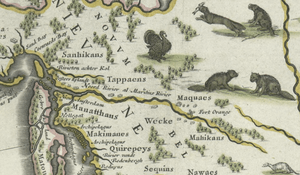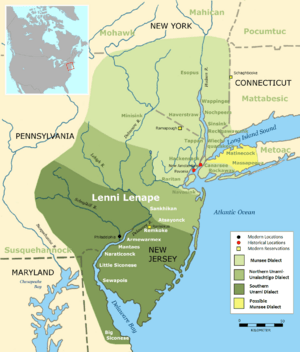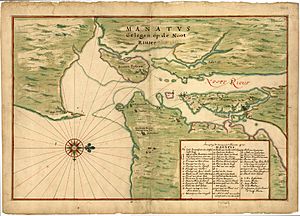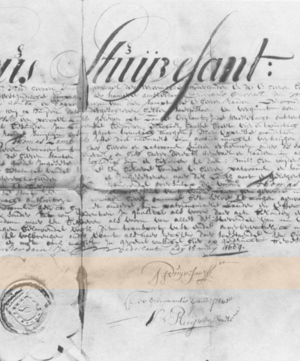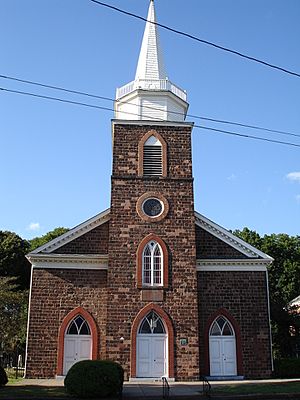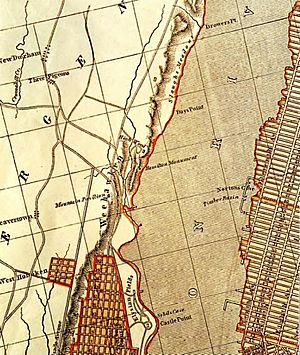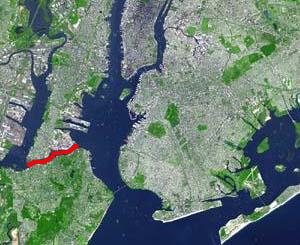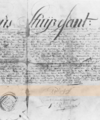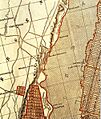Bergen, New Netherland facts for kids
Bergen was once part of a big Dutch province called New Netherland in the 1600s. This area is now in northeastern New Jersey, along the Hudson River and Hackensack River. Even though Bergen officially became its own town in 1661, with a village founded at Bergen Square, its history started much earlier. It began as a trading post at Communipaw around 1615 and was first settled in 1630 as Pavonia. These early settlements were right across the river from New Amsterdam (which is now New York City), and they were under New Amsterdam's control.
Quick facts for kids History ofNew Jersey |
|
|---|---|
 |
|
| Colonial period | |
| American Revolution | |
| Nineteenth century | |
| Twentieth century | |
| Twenty-first century | |
| Timeline of New Jersey | |
Contents
- Exploring the Area: The Halve Maen
- The Lenape People
- Early Settlements: Pavonia
- Achter Col: "Behind the Ridge"
- Kieft's War
- Peter Stuyvesant and New Settlements
- Founding Bergen Square
- The English Take Over: Second Anglo-Dutch War
- The Elizabethtown Assembly
- The Province of New Jersey
- The Hudson-Bergen Line
- Bergen's Lasting Impact
- Images for kids
Exploring the Area: The Halve Maen
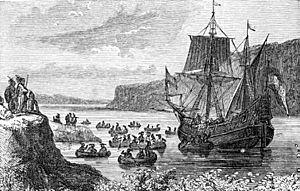
The area around Bergen was first explored by Giovanni da Verrazzano in 1524, sailing for France. Later, Spanish and English sailors visited. In 1609, an Englishman named Henry Hudson arrived. He was hired by the Dutch East India Company to find a water route to Asia.
During his journey, Hudson's ship, the Halve Maen (which means "Half Moon"), stopped at places like Sandy Hook, Harsimus Cove, and Weehawken Cove. These spots are all along the river that is now named after him. Back then, the shoreline looked very different. It had huge tidal marshes and many oyster beds. More expeditions came between 1610 and 1614. Their maps, like one by Adriaen Block, were the first to call the region "New Netherland."
The Lenape People
When Europeans arrived, the land was home to the Lenape people. They were Algonquian groups who moved around with the seasons. The area that became Bergen was the territory of the Unami, or Turtle Clan. These groups were known as the Hackensack Indians and the Tappan. The Hackensack people often camped near the tidal lands, like the Upper New York Bay and New Jersey Meadowlands. The Tappan people lived in the higher lands, from North Hudson to Palisades Interstate Park.
Other related groups also lived nearby, such as the Acquackanonk, Manhattan, and Raritan. Some of these groups were later called Delaware Indians. The Lenape lived in villages surrounded by fences. They grew crops like corn, beans, and squash, and also gathered food, hunted, and fished. Eating shellfish from the huge oyster beds was a big part of their diet.
The Lenape traded with the European settlers, exchanging things like beaver furs for European goods. However, there was a big misunderstanding about land. Europeans thought they were buying land forever. But the Lenape believed they were agreeing to share the land and its resources, keeping their rights to farm, hunt, and fish. The Tappan and Hackensack people had a lot of contact with the settlers. Their leader, Oratam, helped make many agreements and treaties.
Early Settlements: Pavonia
In 1621, the Dutch West India Company (WIC) was created to trade in the Western Hemisphere. By 1625, they had a colony in New Amsterdam (now Lower Manhattan). To encourage more people to settle, the company offered large land grants in 1629.
In 1630, Michael Reyniersz Pauw, a director of the company, bought two areas from the Native Americans. These were at Hopoghan Hackingh (Castle Point) and Ashasimus (Harsimus). His land grant, called a "patroonship," likely covered the entire area between the Hudson and Hackensack Rivers. He named it Pavonia, using a Latin version of his last name, which means "peacock."
A small hut and a ferry landing were built at Powles Hoek (Paulus Hook). However, Pauw didn't bring enough settlers as required by the company. So, he had to sell his land back to the company. In 1633, the WIC built a house for a superintendent, Jan Everts Bout, at Communipaw. Another home was built at Ahasimus in 1634 by Hendrick Van Vorst.
In 1640, David Pietersz. de Vries bought land from the Tappan people and started a settlement called Vriessendael (Edgewater). In 1643, Hoebuk (Hoboken) was leased, and North America's first brewery was built there. These settlements grew into small farming communities. Trade between the Native Americans and settlers involved things like wampum (beads), European goods, and beaver furs. Even though the settlements were small, they were important trading spots with good harbors on the west side of the Hudson River.
Achter Col: "Behind the Ridge"
Many places in the 1600s were named based on their location or features. This was true for Achter Kol (Meadowlands/Newark Bay). "Achter" means "behind," and "kol" means "ridge" or "pass." So, Achter Kol means "behind the ridge," referring to Bergen Neck.
Achter Kol was appealing because it was close to Fort Amsterdam. Its tidal flats were similar to those in the Netherlands. The rivers nearby had many beavers, which meant lots of valuable furs. The river valleys to the north also offered a way to reach the inner lands. The name Achter Kol was used by both the Dutch and later the English to describe the whole area around Newark Bay. This name eventually became Arthur Kill, the channel separating Staten Island from the mainland. The Kill Van Kull is another channel, named for the "ridge pass" behind it.
In 1642, Myndert Myndertsen received a large land grant in this area. He wanted to start a colony called Achter Kol (Bogota). However, a conflict broke out between his workers and the Hackensack people, leading to deaths. This, along with other incidents, caused tensions to rise between the Native Americans and the settlers.
Kieft's War
Willem Kieft became the leader of New Netherland in 1639. One of his goals was to increase profits from the fur trade. Kieft tried to tax the Tappan people, but they refused. In February 1643, some Native American groups attacked others. Many fled to New Amsterdam for safety, but then scattered to Communipaw and Corlears Hook.
Kieft ordered an attack on them on February 25, 1643. This attack was a terrible slaughter. Dutch soldiers killed about 120 people at Pavonia and Corlear's Hook (Lower East Side). In response, the Native American groups united and fought back in October of the same year. They attacked the settlements at Pavonia, forcing survivors to flee to the fort in Manhattan.
A truce was agreed upon in August 1643, but the peace didn't last. For the next two years, the entire province was at war. Finally, a peace treaty was signed on August 30, 1645.
Peter Stuyvesant and New Settlements
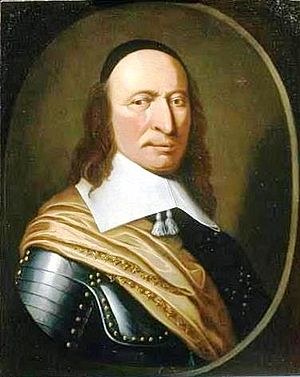
Peter Stuyvesant took over as the new leader of New Netherland on May 11, 1647. More people slowly started to settle in the area. In 1654, the Dutch lost their colony in Brazil to the Portuguese. Many people from there moved to New Netherland. That year, more land grants were given out in Communipaw and Harsimus, extending towards Achter Col and further south.
However, in 1655, settlers and Native Americans clashed again in what was called The Peach Tree War. It's said to have started when a young Native American girl was shot by a Dutchman for picking fruit from a peach tree in Manhattan. This led to calls for revenge. While Stuyvesant and his troops were away, 500 Native Americans attacked Pavonia, killing 100 settlers. They took 150 hostages at Paulus Hook. After being rescued, the hostages returned to New Amsterdam, and the settlements on the west side of the Hudson River were once again emptied.
Founding Bergen Square


People wanted to return to their land west of the North River. So, on January 10, 1658, Stuyvesant "re-purchased" most of the land that would become Bergen Township. This purchase allowed for the founding of the village at Bergen Square. Permission was given to establish the village, and it was officially settled in 1660.
There are different ideas about where the name "Bergen" came from. Some say it's named after towns in the Netherlands or a city in Norway. Others believe it comes from the Germanic word bergen, meaning "hills," which describes the Palisades cliffs in the area. Another idea is that it comes from the Dutch word bergen, meaning "to save" or "to recover," because the settlers returned after fleeing attacks.
Great efforts were made to make the new settlement successful. It was built on a hill west of Communipaw and designed by Jacques Cortelyou. The village was 800 feet on each side and was planned to be surrounded by a wooden fence for protection.
In September 1661, Bergen was granted its own court of justice. This meant it was partly separate from New Amsterdam's control, making it the oldest independent town in New Jersey. Bergen is also home to the longest continuously used school site and Christian church in the state. The communities of Pavonia, Communipaw, Hoebuck, and Achter Col were all under Bergen's authority.
A ferry service between Bergen (at Communipaw) and Manhattan was approved in December 1661. In February 1663, a rule was made about a shared well. The settlers were slow to build the protective fence around the village, so in November 1663, a rule was passed to make sure it was finished. This was so farmers and fishermen could hide if they were attacked.
The English Take Over: Second Anglo-Dutch War
Even though Bergen wasn't attacked directly, it was threatened. On August 27, 1664, four English ships entered the Upper New York Bay. They demanded that the fort at New Amsterdam surrender, which meant all of New Netherland would surrender too. After a few days, Stuyvesant gave in. He couldn't get the people to fight because the Dutch West India Company hadn't sent enough weapons or help when Native Americans attacked before.
Stuyvesant negotiated good terms for the surrender. The Articles of Surrender of New Netherland included a promise that New Netherlanders could keep their religious freedom under English rule. The capture of New Amsterdam led to the Second Anglo-Dutch War between England and the Dutch Republic. Bergen, which had started building a block house for defense, now had to host English soldiers.
The Elizabethtown Assembly
New Netherland was quickly divided. The lands west of the newly named New York City became part of the proprietary colony of East Jersey. The English chose Elizabethtown as their capital, named after the wife of its owner, Sir George Carteret. In October 1664, the Elizabethtown Tract was bought from the Raritan people.
In 1668, representatives from Bergen attended an assembly. Soon after, the Concession and Agreement was issued. This document promised religious freedom and recognized private property in the colony. For people in Bergen, life didn't change much under English rule, though they had to promise loyalty to the new government. English-speaking settlers, mostly from New England, moved into the area.
The wide waterways separated the Dutch and English settlers, allowing the New Netherlanders to keep their language, religion, and traditions. In 1667, the Treaty of Breda formally gave England control of New Netherland. In 1668, the English granted a charter for the "Towne and Corporation of Bergen." They also recorded many land sales to both Dutch and English settlers.
The treaty didn't stop all fighting. In August 1673, the Dutch "recaptured" New Netherland during the Third Anglo-Dutch War. However, news of this didn't reach Holland until January 1674. By then, negotiations for the Treaty of Westminster were already underway. This treaty, signed in March 1674, finally gave control of New Netherland, including Bergen, to the English for good.
The Province of New Jersey
On March 7, 1683, East Jersey was divided into four counties: Essex, Middlesex, Monmouth, and Bergen. Bergen County kept the name given by the Dutch. It stretched from Bergen Point (Bayonne) between the Hudson and Hackensack Rivers, north to the New York-New Jersey state line. The main office for Bergen County was in the Towne of Bergen. Ten years later, in October 1693, Bergen County grew to include more land west of the Hackensack River.
In 1702, East Jersey and West Jersey were joined together to become a royal colony, meaning it was directly controlled by the English crown. New Jersey and New York shared one governor until 1738, when New Jersey got its own governor.
In 1710, Queen Anne of Great Britain ordered Bergen County to be made larger. The village of Hackensack was chosen as the new county seat because it was easier for most people in Bergen to reach. The Town of Bergen received a Royal Charter on January 4, 1714.
The Hudson-Bergen Line
Bergen County was divided into three parts in 1798 when 104 new townships were created across New Jersey.
The original Bergen Township started at Bergen Point. It included the area between the Hudson River to the east and the Hackensack River to the west, extending north to what is now the Hudson-Bergen line. It's not clear why this exact spot was chosen as the border. It might have been where the Lenape groups, the Hackensack and Tappan, marked the edges of their lands. It also matches the border of the early patroonships and Stuyvesant's re-purchase.
Hackensack Township included lands east of the Hackensack River, north of the modern Hudson-Bergen line. This area became known as the English Neighborhood. The current City of Hackensack was part of New Barbadoes Township, which ran north from Newark Bay.
In September 1840, Hudson County was created by separating from Bergen County. The border chosen for the county line on top of the Palisades was the original northern border for Bergen Township. On April 10, 1843, Bergen Township was split in two, creating the Township of North Bergen. Bergenline Avenue, which runs through the North Hudson communities, likely got its name from this division.
Bergen's Lasting Impact
The original street plan for Bergen from 1661 can still be seen at Bergen Square. Nearby are the Old Bergen Church and cemeteries founded by the first settlers. A statue of Peter Stuyvesant stands on the grounds of New Jersey's longest continuously used school site, which was also started by these early settlers. Bergen Square, with its unique layout, was the first of its kind in North America.
Many buildings in the region are built in the Bergen Dutch and Dutch Colonial styles, including old farmhouses and Dutch Reformed Churches. The Sip Manor, originally built in Bergen, was moved to Westfield, NJ in the 1920s. The oldest standing building in Hudson County is the 1690 Newkirk House on Summit Avenue. Another colonial home (around 1742) was built by the Van Vorst family, one of the region's first families. The Steuben House (1752) is a famous example of Bergen Dutch sandstone architecture.
Even as new immigrants arrived, the Dutch settlers kept much of their language, religion, and traditions. Washington Irving, a writer in the early 1800s, often joked about the west side of the Hudson, especially Communipaw, as being a strong center of Dutch culture. Jersey Dutch was a version of the Dutch language spoken in and around Bergen and Passaic counties until the early 1900s.
The region has many place names that come from Dutch family names or geographical terms. Paulus Hook is an example of both. Some Lenape phrases, changed by Dutch and English, are still used today, like Hoboken, Hackensack, Paramus, Secaucus, and Wyckoff. Kill Van Kull still has its purely Dutch name.
The name Bergen is used widely, not just for the county but also in Bergen Point, Bergen Hill, Bergen Arches, Bergenline Avenue, and Bergenfield, among many others. The old patroonship of Pavonia gives its name to an avenue and a train station in Jersey City. The mascot of Saint Peter's College is a peacock, honoring Michael Pauw.
The idea of religious freedom and the recognition of private property are considered some of the most important legacies of New Netherland. Both the surrender terms to the English and the Concession and Agreement allowed people to worship as they wished. These ideas were later included in city, state, and national laws in the United States. Many English words, including "Yankee," and the tradition of Santa Claus come from the settlers of New Netherland.
Like the Netherlands, northeastern New Jersey is known for being diverse and tolerant. It's a place where people from different backgrounds live and interact daily while keeping their unique identities. The idea of "home rule" allows citizens to have a direct say in their local neighborhoods, while also being part of a larger society.
Images for kids
-
Halve Maen on the Hudson River.
-
Peter Stuyvesant was the Director-General of New Netherland.
-
The Newkirk House, built in 1690, is the oldest building in Jersey City.
-
The Van Wagenen House was built by a family of Bergen's first settlers.


